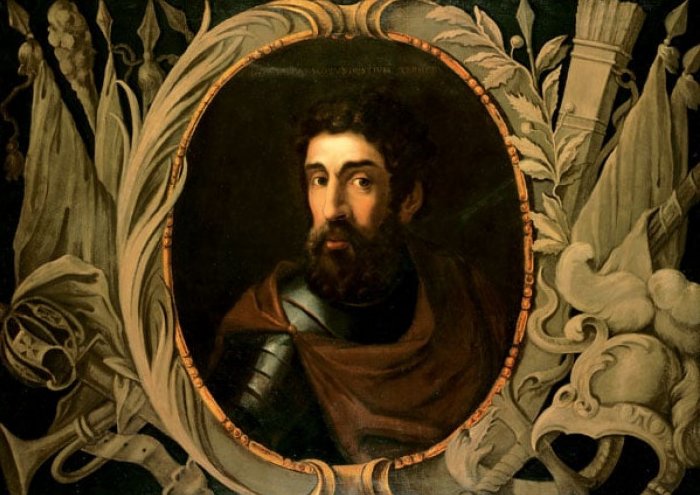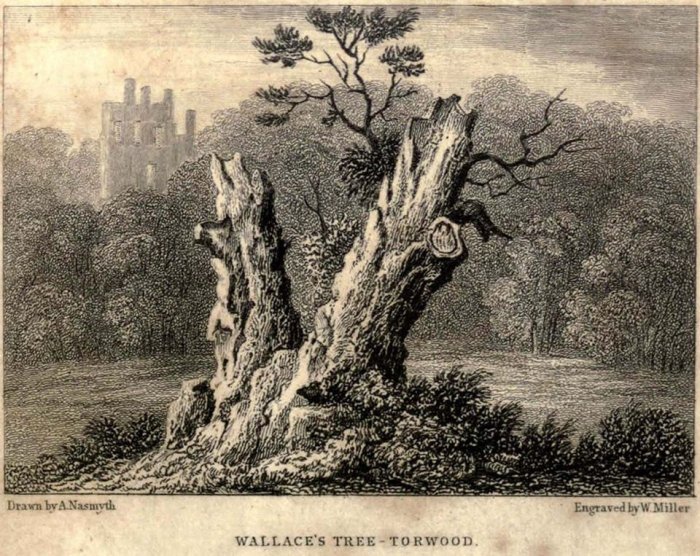THE WALLACE PORTRAIT |
 |
|
|
Half-length portrait of William Wallace (1274-1305) dressed in armour, surrounded by a decorative border. Produced as part of a decorative scheme, probably to be hung above a fireplace or doorway, as an expression of the owner's patriotism. Oil on canvas Provenance – as much as is known Wauchopes of Niddrie Marshall, Edinburgh; W P Wallace, Priory Lodge, Cheltenham; Sotheby's 1974; Sotheby's 2003 (unsold); private collector. Extracted from Stevenson, J. (1841). Documents illustrative of Sir William Wallace: his life and times. [Edinburgh]: Printed for the Maitland club. Portrait: The reader will learn, with considerable interest, that there exists in the possession of H.P. Wallace, Esq., of Priory Lodge, near Cheltenham, a painting which has been considered by competent judges to be an original portrait of the Scottish Hero. The editor cannot give a better description of this valuable memorial, or a more judicious sketch of its history, than is to be found in the following extracts from a letter addressed by its present possessor to the Secretary of the Maitland Club. “The Portrait was procured in France by Margaret Countess of Southesk; and by her presented to an ancestor of mine, Robert Wallace of Holmston, then Sheriff of Ayrshire. “ The above is the inscription on a brass plate. The Picture is framed in the remains of the tree called Sir William Wallace's Oak, from the Torwood, Stirlingshire, cut from the stump in 1779, and given to my father by Sir James Dunbar of Mochrum. “ The Picture is in perfect preservation, and a fine representation of a Scotch warrior of the period. In letters at the top of the Picture, “ GUL: WALLAS: SCOTUS: HOSTIUM: TERROR.' “Mr Wallace of Kelly saw the Picture in my house some time ago, and knew of nothing to compete with it in originality. It answers to the description of the Patriot given by Blind Harry, who alludes to a Picture painted of him in France; but into whose hands such a picture fell is stated to be unknown. “At least the probability is, that this Picture was painted in France, and it is not probable that it was a copy.” | |
 |
|
|
Extracted from 'History and genealogy of the family of Wauchope of Niddrie-Merschell' by James Paterson. Edinburgh : J. Lindsay, printer, 1858.
Pages 40-41 The dining-room, still used as such, on the second floor, is a spacious apartment, lighted from the south. The ceiling is ornamented by finely executed stucco-work, with devices of Scottish royalty — in honour of the Restoration of Charles II. — bearing the date 1661. Above the large fire-place there is a portrait of Sir William Wallace,* painted on canvas, stretched and fixed in panellings on the wall — a fashion which prevailed in the seventeenth and beginning of the eighteenth century. Of this picture, very different from the popular representations of the Scottish hero, there is unfortunately no history. It has been in the house beyond the memory of any of the family, and is evidently of considerable age and excellence as a painting. A copy of this portrait appears, with the kind permission of the proprietor, as a frontispiece to "Wallace and his Times," recently published, where some particulars are given respecting it. It is the same picture — emanating from the same source (if not the original) — as is preserved at Priory Lodge, Cheltenham, belonging to a descendant of the Craigie-Wallace family. In the "Wallace Papers" it is said by the owner to have been presented to his ancestor, Robert Wallace of Holmston, Sheriff of Ayr, by Lady Southesk, who picked it up in France. The portrait at Niddrie House is supposed to have been brought into the family through the marriage of James Wauchope, in 1710, with Jane, daughter of Sir William Wallace, Bart, of Craigie. Sir William was doubly connected with the Niddrie family. He had married, as his second wife, Elizabeth Wauchope; and James, her brother, was his son-in-law. He left no male issue, and was succeeded by his brother. He commanded a regiment of cavalry under King James, and followed that monarch when he retired to France. The Craigie family and estate suffered considerable dilapidation in consequence, and the picture in question may have found its way to Niddrie House during these troubles.** It appears in inventories a hundred and fifty years back, whereas the Priory Lodge Picture cannot be traced farther than about 1734, when Robert Wallace of Holmston was Sheriff of Ayr. In the same apartment there are several portraits of the Wauchope family — the oldest of which are those of Sir John and the lady of his son, Andrew — fixed in pannellings to the wall. In inventories of the furniture in Niddrie House in 1707-11, the picture of "Wallace" is mentioned as an item by itself. In another, 1715, "13 fyne pictures of family and freindes," are mentioned, as in the "bigg dyning room;" but no particular notice of the portrait of Wallace occurs. * It has an inscription intimating it to be the portrait of the great hero. ** Amongst the Niddrie papers there is a genealogical account of the family of Craigie-Wallace, in MS., down to 1719. At all events, the picture of Wallace in the dining-room does not correspond in any way with the style of the period. Information from http://www.cracroftspeerage.co.uk/southesk1633.htm James [Carnegie], 5th Earl of Southesk born 4 Apr 1692 mar. 11 Jun 1713 Lady Margaret Stewart (mar. (2) 16 Aug 1733 as his first wife Hon John St Clair, Master of Sinclair; dsps. 22 Jul 1747), 1st dau. of James [Stewart], 5th Earl of Galloway, by his wife Lady Catherine Montgomerie, 1st dau. by his first wife of Alexander [Montgomerie], 9th Earl of Eglinton children 1. Hon James Carnegie, styled Lord Carnegie (b. c. 1714; dvp. 7 Jan 1722) 1. Lady Clementina Carnegie (d. 26 Mar 1730) died s.p.m.s. 10 Feb 1729/30 suc. by kinsman in 1855 note attainted 1715 by Act of Parliament and his estates and honours forfeited to the Crown Extracted from "History of the Carnegies, Earls of Southesk, and of their kindred" by William Fraser. Edinburgh : T. Constable, 1867. 2 volumes. JAMES FIFTH EARL OF SOUTHESK, 1699-1730. Page 185 In consequence of the part which he thus took in the insurrection, Earl James was attainted, and his estates were forfeited to the Crown by the Act of 1 George I. cap. 42. The Act narrates, that as George Earl Marischall, William Earl of Seaforth, James Earl of Southesk, and many other noblemen and gentlemen, on or before the 13th day of November 1715, did, in a traitorous and hostile manner, take up arms and levy war against his Majesty contrary to the duty of their allegiance, and had fled to avoid being apprehended, it was enacted by the King and both houses of Parliament, that if they did not surrender themselves to one of his Majesty's Justices of Peace, on or before the last day of June 1716, they should be adjudged attainted of High Treason from and after the said 13th of November 1715; and every Justice of Peace was required to commit them to prison, and to give notice thereof to one of the principal Secretaries of State. Earl James did not surrender himself to the authorities, and the Act of Attainder took full effect on his titles of honour and territorial estates. He escaped to France, where, after an exile of about fifteen years, he died, on 10th February 1730, without having ever returned to his native land. About two years before the insurrection of 1715, the Earl of Southesk married a highly accomplished lady, Lady Margaret Stewart, eldest daughter of James fifth Earl of Galloway. Their contract of marriage is dated 11th June 1713, on which day their marriage took place. Page 191 The difficulties of her position prevented the Countess from joining her husband so early as she had anticipated ; or if she did actually visit him, as she proposed, in the year 1720, she returned to Scotland before April 1723, as on the 6th of that month she granted at Edinburgh a commission to a factor to arrange her affairs with the York Buildings Company as purchasers of the estate of Southesk. That Commission narrates that the Countess is to be furth of Scotland for some time, and that it will be necessary in her absence to appoint a person to settle with the said Company her claims on the estate of Southesk. Pages 193-4 Lady Southesk appears to have resided with her husband on the Continent from 1723 to 1727. On the 25th November of the latter year, when just recovering from what she calls a severe fit of sickness, she wrote to Lord Milton asking him to assist her in obtaining a pass to return to Scotland. She stayed, it would seem, at Rotterdam from July to 6th November 1727, waiting for a pass from the British Government. The exact time when she obtained permission to return to Scotland, and the place where she resided, during nearly a year and a half, from November 1727, are uncertain; but on the 4th of June 1729, she, along with her sister, Lady Catharine Stewart, arrived at Edinburgh from Holland. Page 195 Under the designation of the Honourable Margaret Lady Sinclair, she was infefted in an annuity of 5000 merks furth of the baronies of Eavenscraig and Dysart, on 30th December 1735. Lady Sinclair died without issue, at Edinburgh, on the 22d July 1747. Taking in all of the above, the earliest date that the Priory Lodge painting could have entered Robert Wallace's possession is 1729, when Lady Southesk returned from abroad, and the latest date 1747, when she died. Concerning the references to the Wauchope painting, there appears to be some confusion with regard to its antiquity, and the provenance also is somewhat imprecise. Both references, however, refer to Lady Southesk, and the only lady of that name who appears to fit is the wife of the 5th Earl. The dates correspond well, and also the letters regarding her time abroad after her husband was attainted. |
| © Society of William Wallace 2007-2025 | The Society of William Wallace is a Scottish Charitable Incorporated Organisation Registration number SC045959 |
